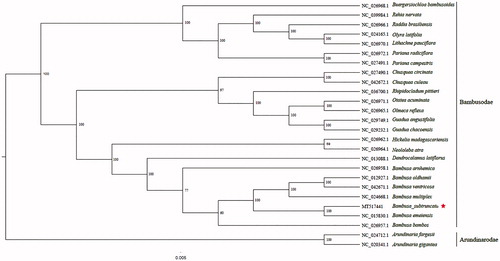Abstract
Bambusa subtruncata is found in Xinyi county, Maoming city, Guangdong province, China. In the current study, we sequenced the complete chloroplast genome of B. subtruncata and reported for the first time. The genome was 139,444 bp in total length, including a large single-copy (LSC) region of 82,956 bp, a small single-copy (SSC) region of 12,897 bp, and a pair of invert repeats (IR) regions of 21,798 bp. Plastid genome comprised of 127 genes in total; 82 protein-coding genes, 37 tRNA genes, and eight rRNA genes. Phylogenetic analysis based on 25 chloroplast genomes indicates that B. subtruncata is closely related to Bambusa emeiensis in Bambusodae.
Bambusa subtruncata is one of the excellent ornamental bamboo species with good cold resistance. The bamboo leaves become yellow and whorl under cold conditions, but this species recovers quickly without impacting the growth and landscape (Teng Citation2013). B. subtruncata can normally grow 4–5 meters tall with a diameter of 2–2.5 cm, and an internode length of 25–30 cm. It is very similar to Huamei Bamboo in appearance. The chloroplasts (cp) genome has a maternal inheritance and conserved structure, which has been used for investigating evolutionary and phylogenetic relationships of plants (Wang et al. Citation2018). Therefore, we reported the complete chloroplast genome (cp) of B. subtruncata based on Illumina pair-end sequencing data. Fresh leaves tissues of B. subtruncata were collected from Fujian province, China (Fujian Agriculture and Forestry University, Bamboo Garden, Fuzhou: 119°14´16′´E, 26°5´7′´N) and dried into silica gel instantaneously. The specimens were kept in the Herbarium of College of Forestry, Fujian Agriculture and Forestry University (specimen code 101301). DNA was extracted from fresh leaves tissues, with 500 bp randomly interrupted sequence by the Covaris ultrasonic breaker for library construction. The constructed library was sequenced PE150 by Illumina Hiseq Xten platform, with ∼2GB data generated. Illumina data were filtered by a script in the cluster (default parameter: -L5, -p0.5, -N0.1). The complete plastid genome of Arundinaria faberi (GeneBank accession: JX513414) as reference and plastid genome of B. subtruncata was assembled by GetOrganelle pipe-line (https://github.com/Kinggerm/GetOrganelle). It can get the plastid-like reads, and the reads were viewed and edited by Bandage (Wick et al. Citation2015). The cp genome annotation was assembled based on the comparison by Geneious v 11.1.5 (Biomatters Ltd, Auckland, New Zealand) (Kearse et al. Citation2012). The annotation result was drawn with the online tool OGDRAW (http://ogdraw.mpimp-golm.mpg.de/) (Lohse et al. Citation2013).
The complete plastid genome sequence of B. subtruncata (GenBank accession: MT517441) was 139,444 bp in length, with a large single-copy (LSC) region of 82,956 bp, a small single-copy (SSC) region of 12,897 bp, and a pair of inverted repeats (IR) regions of 21,798 bp. The complete chloroplastid genome contained 127 genes, including 82 protein-coding genes, 37 tRNA genes, and eight rRNA genes. The complete genome GC content was 38.9%. To reveal the phylogenetic position of B. subtruncata with other members of Bambusodae, we performed a phylogenetic analysis based on 23 complete chloroplast genomes of Bambusodae, and two taxa (Arundinaria fargesii, Arundinaria gigantea) as outgroups. All of them were downloaded from NCBI GenBank. The sequences were aligned by MAFFT v7.307 (Katoh and Standley Citation2013), and the phylogenetic tree was constructed by RAxML (Stamatakis Citation2014). The phylogenetic tree revealed that B. subtruncata was most closely related to Bambusa emeiensis with strong support ().
Acknowledgements
The author thanks anonymous reviewers who provided helpful suggestions and critical comments on this manuscript.
Disclosure statement
No potential conflict of interest was reported by the author(s).
Data availability statement
The data that support the findings of this study are openly available at https://www.ncbi.nlm.nih.gov/ GeneBank with following accession number MT 517441.
Additional information
Funding
References
- Katoh K, Standley DM. 2013. MAFFT multiple sequence alignment software version 7: improvements in performance and usability. Mol Biol Evol. 30(4):772–780.
- Kearse M, Moir R, Wilson A, Stones-Havas S, Cheung M, Sturrock S, Buxton S, Cooper A, Markowitz S, Duran C, et al. 2012. Geneious basic: an integrated and extendable desktop software platform for the organization and analysis of sequence data. Bioinformatics. 28(12):1647–1649.
- Lohse M, Drechsel O, Kahlau S, Bock R. 2013. OrganellarGenomeDRAW-a suite of tools for generating physical maps of plastid and mitochondrial genomes and visualizing expression data sets. Nucleic Acids Res. 41(Web Server issue):W575–W581.
- Stamatakis A. 2014. RAxML version 8: a tool for phylogenetic analysis and post-analysis of large phylogenies. Bioinformatics. 30(9):1312–1313.
- Teng ZY. 2013. The cold resistance research of Hunan’s sympodial ornamental bamboo. Changsha (China): Hunan Agricultural University
- Wick RR, Schultz MB, Zobel J, Holt KE. 2015. Bandage: interactive visualization of de novo genome assemblies. Bioinformatics. 31(20):3350–3352.
- Wang J, Li C, Yan C, Zhao X, Shan S. 2018. A comparative analysis of the complete chloroplast genome sequences of four peanut botanical varieties. PeerJ. 6:e5349

